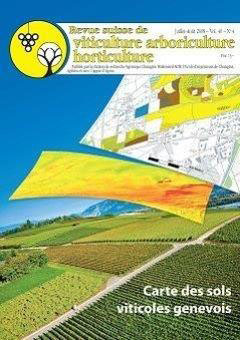
Issue 4 - July - August 2008
Abstract in open access
The canton of Geneva, like the other French speaking cantons of Switzerland, has now a vineyard soil map. This map, at 1:7500 scale, allows for a very precise characterisation of the spatial variability of the soils. Furthermore, the description of 850 auger probes and 95 soil profiles offers punctual information particularly interesting for the vine growers. Knowing soil type and its functions gives useful information for the choice of rootstock and grape variety, for soil surface management or for preparing new plantation. This map is also a good basis for more precise characterisation of the soil at the exploitation scale.
Keywords: Key words: terroir, soil, cartography, viticulture, Switzerland.
E-Mail: stephane.burgos@eichangins.ch
Adress: Agora
Abstract in open access
Two trials of soilless truss tomato crops were realized in a glasshouse under low temperature conditions. Twelve varieties were examined in 2006 and ten in 2007. The behaviour of plants, the yield and the external, analytical and sensory quality of the tomato varieties under these conditions were analysed. Deformations of the trusses were recorded particularly during the first two months of harvest when the low temperature regime began before the bloom of the 3rd truss. The varieties Plaisance, Climberley, Altess and Idooll grafted on Maxifort performed best under these conditions. Climberley offered also the best compromise yield-sensory quality. This variety was also most appreciated by the consumers. Vitamin C and carotenoïd showed variety and seasonal variations.
Keywords: low temperature, truss tomato varieties, agronomic values, external quality, analytical and sensory quality.
E-Mail:
Adress: Agora
Abstract in open access
Shiso [pronounced she-so] is a culinary, aromatic, medicinal, cosmetic and ornamental plant cultivated in Asia since Antiquity. Ten different kinds of shiso were tested on their adaptation for cultivation in Switzerland, on their phytochemical properties (antioxydant and anti-allergenic) and their culinary use. They were classified into four known types: «Ao shiso» or «Egoma» with green leaves and «Aka Shiso» or «Nankinensis » with red leaves. «Ao shiso» proved to be the most interesting for rosmarinic acid (antioxydant) and apigenin (anti-allergenic) contents as well as for Japanese cooking (sushi). «Egoma» was the richest in essential oil. «Aka shiso» and «Nankinensis » stood out with their luteolin content (anti-allergenic). The linolenic acid (omega-3) content in the seeds tested was above 60% of the total fatty acids. The preliminary results confirm the feasibility of shiso cultivation in Switzerland. The important morphological and phytochemical variability of the different shisos offers interesting perspectives for multiple uses in food, cosmetics or medicine.
Keywords: Perilla frutescens, antioxidant, antiallergenic, beefsteak plant, Switzerland, linolenic acid.
E-Mail:
Adress: Agora
Abstract in open access
A comparison of old and young vine plants, with respect to their viticultural and oenological properties, was made between 2002 and 2006 at the experimental estate of Leytron (Wallis, Switzerland), in a trial study set up by the Research Station Agroscope Changins-Wädenswil ACW. Six rootstocks were included in the study: Chasselas, Pinot blanc, Arvine, Gamay, Syrah and Humagne rouge. Grape sugar content was found to be equivalent irrespective of vine plant age. Both total must acidity and values of the formol index were greater in old vine plants. Generally speaking, old vine plants of red wine rootstocks produced better noted wines than young ones, particularly in relation to tannin quality, judged to be fuller and more firm, and to their better structure. At tasting, white wines didn’t show much difference between those issued from old and young vines. After several years in bottle, wines produced from old grapevines were slightly preferred to those of young vines, for both red or white wine root stocks.
Keywords: grapevine age, yield, grape and wine quality.
E-Mail: vivian.zufferey@agroscope.admin.ch
Adress: Agroscope, 1009 Pully
Abstract in open access
During the years 2004 and 2005, the ripening of Pinot noir was followed on fifteen plots using two methods: sensory analysis of berries and analysis of anthocyanins to monitor the evolution of phenolic compounds. The berries of three plots were harvested at successive dates. Vinifications were made separately. Phenolic maturation follow-up using anthocyanins analysis did not provide pertinent information to forecast phenolic maturity. The maturation follow-up using sensory analysis of berries showed irregular results. Some descriptors appeared however to be of interest. Overall, it has not been possible to identify reliable criteria to help deciding on the appropriate harvest date of Pinot noir.
Keywords: ripening, maturation, phenolic compounds, anthocyanin.
E-Mail: philippe.dupraz@eichangins.ch
Adress: Agora
Abstract in open access
A survey intended to preserve the genetic diversity of the Muscats cultivated inValais (Switzerland)was carried out in old vineyards. It came out that two distinct grapes are cultivated under the name Muscat, and their identity was established on the basis of ampelographic observations and DNA testing: ‘Muscat Blanc à Petits Grains’ and ‘Moscato Giallo’, an Italian grape also called inValais ‘Muscat du Pays’, ‘MuscatVert’or ‘Muscat Italien’. Moreover, ampelographic observations of 196 old Muscat vine stocks from Valais showed a great phenotypical variability among the ‘Muscat Blanc à Petits Grains’ population.
Keywords: Muscat Blanc à Petits Grains, Moscato Giallo, ampelography, DNA, Valais, Switzerland.
E-Mail: jean-laurent.spring@agroscope.admin.ch
Adress: Agroscope, 1009 Pully

 Download of full issue
Download of full issue
 Download article
Download article